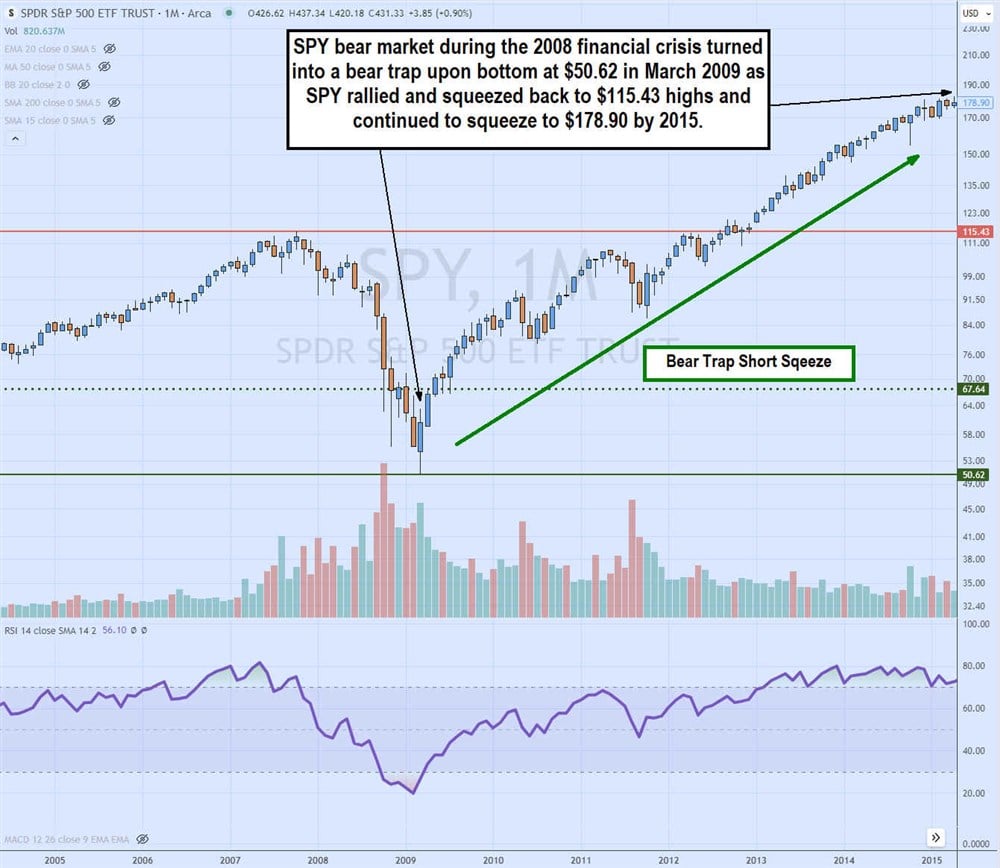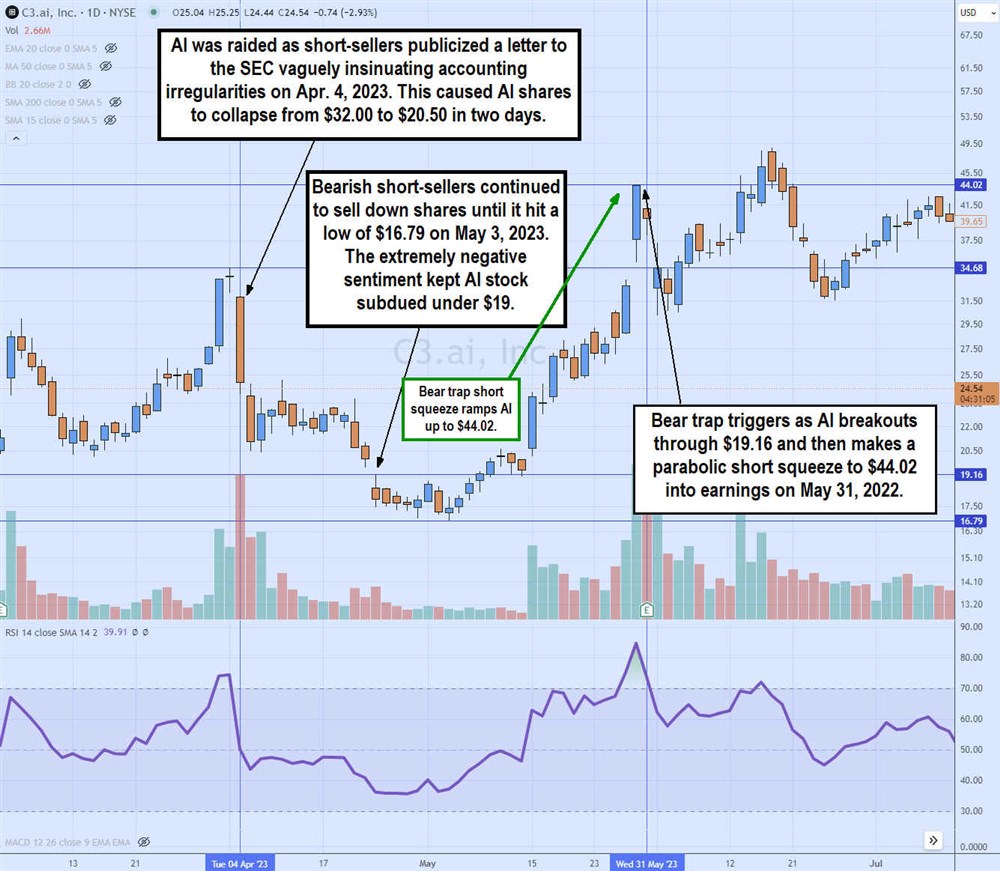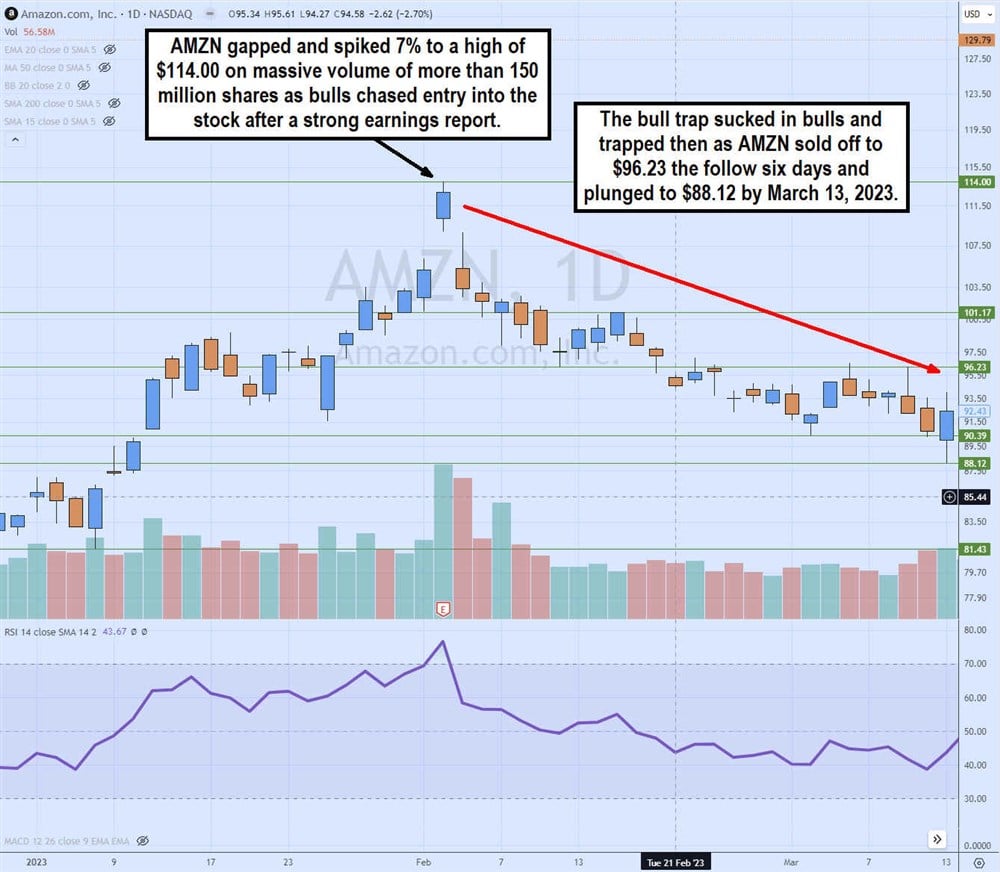It’s a violent reversal of sentiment that can take a weak stock and shoot it higher driven by desperate short-sellers trying to cover their losses. Like the proverbial bear that inadvertently steps on a bear trap and is left writhing in pain, the same applies to short sellers trapped in a strong reversal. This article will deeply dive into "what is a bear trap?" and how it can impact investors.
We’ll also look at some real examples and how to trade them. By the end of this article, you will be more aware of bear traps and how to manage them.
What is a bear trap?
What is a bear trap in stocks?
A bear trap is a “rope-a-dope” situation in a falling market or stock that draws in bears, believing it’s headed lower, but violently reverses back up, triggering a short squeeze fueling higher prices. It's a well-laid trap that tricks bears into believing the stock has further to fall but surprises them with a reversal followed by a short squeeze.
This reversal of sentiment can be violent, volatile and unexpected. The unexpected element traps the bears, believing the initial bounce is a wiggle ahead of further selling. However, the bounce gains steam and vigorously grinds higher, causing a panic reaction as bears scramble to cover their shorts. It’s great for bulls and terrifying for bears.
Bear traps are most effective when they initially start with a fast drop in the stock. This causes panic selling, tempting bears to jump in shorting the stock. As the short becomes "crowded," a capitulation bottom tends to occur quickly, followed by a sharp reversal higher take, which surprises the bears. The reversal's speed, velocity and magnitude cause panic as bears frantically try to cover their shorts to avoid further losses. This generates more buying pressure, causing shares to continue to rally.
Another version of a bear trap happens when a stock moves higher and appears to have peaked out. As the stock reverses back down, short sellers jump on the bandwagon, expecting a larger sell-off after the irrational move up. Just as the stock appears that it may break, it surges back up again through its prior highs, trapping the old and new short-sellers as they rush to try to cut their losses, which propels shares higher.
Bear traps can happen in bull and bear markets but are more common in bear markets due to the general negative market sentiment. Bear traps rely on complacency on the part of the bears as they get comfortable with their short positions, expecting the market to continue lower. Bear traps can mark significant reversal points in downtrending stocks, which can help investors find an entry point into positions they’ve been waiting to enter.
Bear traps can deceive sellers who believe the stock is much lower to fall. Bear traps are not an exact stock pattern, as many existing patterns contain bear traps. Bear traps are a phenomenon that often develops when a trade gets crowded on the short side. They help put in the bottom of a downtrend and a reversal into a breakout and uptrend.
Understanding bear markets
Bear traps occur when there is an abundant amount of negative sentiment for a stock. The context is also important, which makes them more common in bear markets. Market corrections refer to markets that are trading 10% below their highs. Bear markets refer to markets trading more than 20% below their highs for at least 60 days. As they say, a rising tide lifts all boats. This applies in bull markets, and the opposite applies in bear markets.
Recessions also tend to occur during bear markets. The biggest problem with predicting bear markets and recessions is that they are only confirmed after they happen. Using technical chart patterns with specific bearish patterns, like a death cross, can help to identify bear markets in stocks, just as we can use a golden cross to identify a bull market in stocks. In bear markets, stocks tend to sell off regardless of fundamentals. For financial planning and wealth management, identify bear markets even after the fact and consider ways to hedge or limit exposure to the long side. Bear traps can trim down long exposure during the short squeeze.
The role of bear traps in financial markets
Bear traps trigger an immediate reversal of sentiment from negative to extremely bullish, dictated by the parabolic price action. They result in short squeezes as bears get sucked into the short only to get short squeezed out. As much as investors hate bear markets and short sellers, they are necessary for bull markets and uptrends. When stocks break out, the initial catalyst can often be the short sellers attempting to cover their positions, driving up prices, causing buyers who were on the fence to take their positions.
Investors who stopped out can reconsider and buy back in. As shares move higher, fear of missing out (FOMO) can kick in, causing investors to chase stock prices higher as bears continue to cover their shorts. All this starts with short sellers covering their short positions, which generates buying pressure.

Bear traps have helped to solidify the bottom of market corrections and bear markets. The 2008 financial meltdown saw the S&P 500 index NYSEARCA: SPY collapse from $115.43 in October 2007 to the $50.62 low in March 2009, triggering a bear market trap. Short sellers who were complacent or entered late shorts fell into the bear trap as the SPY rebounded to the $115.43 high by April 2012 and continued to rally to $178.90 by 2015. This was a bear trap stock market.
Common characteristics of bear traps
How does a bear trap work?
Bear traps tend to have some common characteristics underscoring the bear trap meaning. Here are three characteristics most bear traps have.
- They start with a sharp decline in prices. Most bear traps occur when a stock price takes a sharp or extended sell-off, putting the stock on short sellers' radar. As the stock continues to wallow in weakness, new short-sellers emerge to ride down the falling prices. The negative sentiment tends to result in complacency as bounce attempts get absorbed by more sellers, which sucks in the bears.
- They trigger a sharp price reversal higher. As the stock shows little signs of reversal, it can quickly make a short-term reversal on news or events. This surprises bears as they start to cover their shorts as prices rise. Each candlestick that closes green gets more bears to consider covering their shorts until a sharp price spike occurs.
- They panic bears trapped in a short squeeze. After the sharp price spike, bears started to panic and chase the stock higher as they panicked to cover their shorts. By chasing the price and covering shorts, the buying pressure increases. If shares rise high enough, margin calls and forced liquidation can accelerate the stock. Buyers reluctant to buy the stock lower may enter it as it reflects more strength. Buyers on the fence get knee-jerked by FOMO as they don't want to miss out on the rally.
Identifying bear traps
First, scan for stocks with sharp price drops. Stocks with unusual volumes happen due to news, earnings results, conference calls, events, downgrades or even short seller reports. Stocks that make fast drops usually appear on screeners, drawing more attention and participants looking for short entries. Be sure that you are aware of what catalyst drives shares lower.
Bear traps can occur on all stocks, from penny stocks to blue chips to large caps and even dividend stocks. However, stocks with a smaller float tend to be more susceptible since the thinner liquidity has more potential to trigger panic.
You can find stocks that make headlines for sharp price drops on scanners and news feeds. Short-sellers perform bear raids by releasing their bearish research reports to sour sentiment on their prey. They publicize their bearish research to gain more attention. It can draw more participants to the stock in question when this occurs, such as during the artificial intelligence (AI) boom with C3.ai Inc. NYSE: AI. Here’s the bear trap stock example with AI.

On April 4, 2023, short seller Kerrisdale Capital publicized a U.S. Securities and Exchange Commission (SEC) letter alleging fraudulent accounting practices with C3.ai. The letter was a short report with subjective points meant to be publicized. This caused AI stock to collapse from $32 to $20.50 in two days. This price drop and extremely heavy volume drew attention from the press, causing traders and investors to take note. The stock could not bounce as more bears joined the party, jumping on the short trade and causing AI to break down through the $19 support level to collapse to a low of $16.79 on May 3. The stock started to recover back through $19.16, which caused some bears to cover their shorts.
On May 15, 2023, AI made a 23% bounce from $20.20 to $24.31, triggering the bear trap. AI announced it was raising its upcoming earnings guidance before the earnings release. Short sellers were caught offside as a violent short squeeze ensued. Complacent bears were caught off guard as volume started to rise in the coming day as sharp rallied to a high of $44.02 by May 30. The bear trap trade successfully squeezed short sellers into the earnings report, which caused shares to fall back to the $30 range, but the damage was done as illustrated on the bear trap chart.
The psychology behind bear traps
Bear traps occur based on the two emotions that control the stock market: fear and greed. Fear causes investors and traders to panic out of a sharply falling stock. Short sellers get greedy, stepping into the falling stock, hoping to gain more profits on a deeper sell-off. As the stock nears a capitulation, complacency takes over as profitable bears ignore price chop until the bear trap triggers and a sharp price reversal ensues.
This causes fear to spawn and grow as the stock rallies back up. As bears see their profits turn into losses, fear causes them to panic, and they frantically try to cover their shorts. What was a solid profit turns into deepening losses as they desperately sprawl to get out of their positions with heavy losses.
Bear trap vs. bull trap
As bears get sucked into a falling stock that makes a sharp reversal to form a bear trap, the same can happen with bulls.
A bull trap is the inverse version of a bear trap. In a bull trap, the stock makes a sharp spike that causes bulls to buy into the stock. Bulls end up chasing the bear trap stock higher from FOMO. As the stock attempts to make new highs, it reverses sharply and collapses, causing bulls to panic as shares collapse even further.
Bear traps
Bear traps start with a sharp drop that sucks in the short-sellers and makes a sharp reversal backup. The reversal gains momentum and accelerates as bears get trapped in a short squeeze.
Bull traps
A bull trap starts with a sharp rally that causes bulls to chase the stock higher. A sharp reversal down causes bulls to sell their stock. As shares fall lower, bulls get more nervous and panic out of their positions. Each bounce attempt gets absorbed by sellers until the bulls throw in the towel. At this point, a capitulation bottom may be reached.

The Amazon.com Inc. NASDAQ: AMZN daily candlestick chart illustrates the bull trap as AMZN gapped up over 7% and rallied to $114 on its earnings results on February 2. The trading volume spiked to over 158 million shares. Instead of rallying higher the next day, shares fell over 8% on profit-taking. AMZN continued to sell off for five days until it attempted to bounce off $96.23, putting the nervous bulls at ease. AMZN peaked at $101.17 after the three-day bounce and sold off to a low of $88.12 by March 13, 2023. The bull trap was completed and shook out AMZN earnings buyers in a reverse bear trap.
Risks and consequences of falling into a bear trap
Bear traps are risky for both bulls and bears. The consequences can be catastrophic. Bulls can get panicked from long positions on a bear trap's initial sharp price drop phase.
As the stock continues to fall, new bears take short positions, hoping for the stock to drop much further. While initial profits may develop, the bears expect larger profits as greed takes over. As the trade gets crowded, the stock sharply reverses higher. The bears lose profits but stick to their guns, believing the stock will fall back.
However, the stock starts to accelerate to the upside without slowing down. What was a small profit has been lost and is now turning into a large loss. As the price rises, bulls panic and desperately try to cover their short positions. As they chase the stock, prices rise faster. Bears that stick to their guns too long may blow out their account, hoping and wishing the price would fall back down. This can take a drastic financial and psychological toll on anyone caught in the bear trap with shorts.
Strategies to avoid and navigate bear traps
The most important aspect of bear traps is to avoid taking large losses. Bear traps can be nasty for short sellers because the losses can be infinite. Bear trap trading is riskier than bull trap trading.
A bull caught in a bull trap can only lose the total amount of the stock if it drops to zero. However, a bear stuck in a bear trap can lose much more since the stock could move infinitely higher, causing losses to magnify well beyond a trader's capital. If you think this can't happen, look at stocks like Tesla Inc. NASDAQ: TSLA, which rose from the $40s to nearly $4,000 pre-split in just two years. Remember this when deciding to trade a bear trap vs. bull trap or bull trap vs. bear trap.
Here are some tips to manage bear traps:
- Use technical analysis patterns. Always use charts with indicators and look for patterns if you play bear traps. While bear traps are associated with short selling, they can traded more successfully on the long side. Look for bullish reversal patterns like bull flags, inverse head and shoulders and triangles to spot entries.
- Use a momentum indicator. A momentum indicator keeps you aware of when stocks are in oversold territory or have an oversold condition. Make sure not to short stocks when they are already oversold. For example, a stock with a relative strength index (RSI) under the 30-band is oversold and has the potential risk for a bear trap if shorted there.
- Don’t chase shorts down. The most important factor for avoiding bear traps is to avoid chasing stocks down for shorts. FOMO applies for bulls on the way up and bears on the way down for stock prices. Using a momentum indicator can also show you when a stock is getting extremely oversold, which lowers your chance of further downside and raises the chances of a bear trap reversal.
- Manage your stop losses. This is the most important aspect of bear trap protection. Consider your stop-loss price levels before you enter a trade, especially if it's short. If the stop-loss price is triggered, then you must cut your losses immediately with no questions asked. Poor discipline in following this rule is a key reason for traders getting caught in bear traps and blowing out their accounts.
Watch earnings season dumpers for bear traps
Earnings season is when a large number of bear traps can occur. Dumpers are stocks that gap down sharply on earnings results. The sharp price drop comes from earnings shortfalls or guidance drops. Stocks will gap down and tend to stay down or fall lower in most cases. However, a few stocks will gap down, form a sharp reversal at some point in the day and continue to recover to pre-earnings prices.
The bear trap gets stronger if the stock rallies into the green and higher after initially gapping down. The best way to find these candidates is to use a screener like MarketBeat Stock Screener and watch for stocks with large gaps down and heavy volume.
Before you consider Amazon.com, you'll want to hear this.
MarketBeat keeps track of Wall Street's top-rated and best performing research analysts and the stocks they recommend to their clients on a daily basis. MarketBeat has identified the five stocks that top analysts are quietly whispering to their clients to buy now before the broader market catches on... and Amazon.com wasn't on the list.
While Amazon.com currently has a "Buy" rating among analysts, top-rated analysts believe these five stocks are better buys.